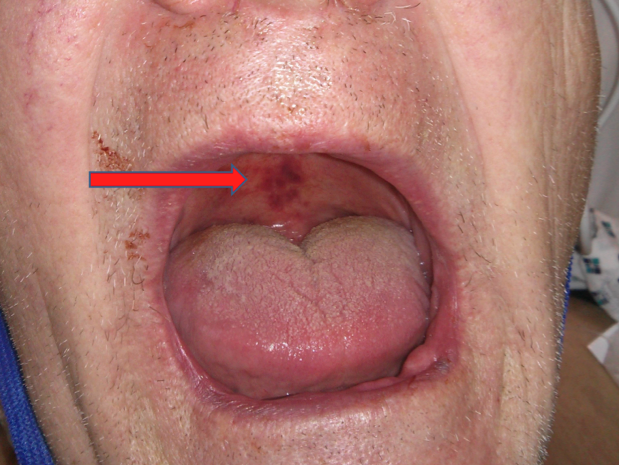An unusual cause of inspiratory stridor: NG tube insertion under anaesthesia
Kristofor Inkpin and Matthew Daunt
Cite this article as: BJMP 2015;8(4):a838
|
|
Abstract Insertion and use of nasogastric (NG) tubes is not without risk. We report a case of inspiratory stridor following NG tube insertion whilst under general anaesthesia. We describe its diagnosis, treatment and precautions to prevent further incidents. Keywords: NG tube, Stridor, Airway, Emergency, blind.Abbreviations: NG - Nasogastric, NHS - National Health Service, AF - Atrial Fibrillation, CT - Computerised Tomography. |
Introduction
The NHS is supplied with approximately 300 000 NG tubes per year1. There are approximately 800-1000 incidents reported to the NPSA every year related to the insertion and use of NG tubes. Difficulties are often encountered with their insertion, especially in the setting of general anaesthesia. Whilst stridor and injury related to the use of NG tubes has been previously reported2,3, it has been related to prolonged siting. We describe a case acute stridor occurring in the recovery room due to direct trauma of the airway upon NG tube insertion.
Case report
A 61-year-old male presented with clinical symptoms of bowel obstruction. His medical history included atrial fibrillation (AF) treated with flecainide, and a 30-pack year smoking history. He was previously independent with a World Health Organisation performance status of 0. After CT confirmation of bowel obstruction, he was scheduled for an emergency laparotomy. A predicted P-Possum 30 day mortality was calculated at over 10%. He required no organ support pre-operatively, although his AF was poorly controlled. He had a low thoracic epidural sited awake, followed by induction of general anaesthesia with a rapid sequence induction. An arterial line, a central venous line, and an NG tube were inserted once anaesthetised. The NG tube was documented as difficult to site, and there were several attempts at a blind insertion via the oral and nasal route, before successfully inserting under direct vision using a laryngoscope.
The operative finding was that of an unresectable caecal tumour, and a defunctioning loop colostomy was formed. The total duration was 150 minutes. Following peripheral nerve stimulation and administration of 2mg/kg Sugammadex, he was woken, extubated and escorted to recovery.
Within minutes of being in the recovery area, he was acutely stridulous. Emergency assistance was called, and after assessment he was given nebulized adrenaline (1mg diluted in 4mls 0.9% saline), and 200mg of intravenous hydrocortisone. The nasogastric tube was removed, and his breathing was then supported with CPAP via a Mapleson C circuit and 100% oxygen. Direct examination of his airway, and indirect nasendoscopy with a Storz fibre-optic scope were performed. Significant bruising of his soft palate was seen, in addition to bruising and oedema of the soft tissues around the arytenoid cartilages with a small haematoma within the valleculae [Figure 1]. After approximately twenty minutes his stridor settled.

He was transferred to a level 2 high dependency unit later that day. He did not suffer from any further airway compromise, and his symptoms completely resolved.
Discussion
The insertion of an NG tube, whilst often deemed low risk, may result in life threatening consequences4. There even exists a “NG tube syndrome” 5, the pathophysiological mechanism of which is thought to be paresis of the posterior cricoarytenoid muscles secondary to ulceration and infection over the posterior lamina of the cricoid. There is no doubt that insertion of an NG tube in the anaesthetised patient can prove to be difficult, with a failure rate of up to 50% on first pass6, with repeated attempts at insertion being required. However, this case highlights the need for a controlled and ordered approach to managing the difficulties that can be encountered. Medical training incorporates NG insertion as a basic skill within the curriculum, but this affords new anaesthetic trainees little help with the anaesthetised and intubated patient.
There are several techniques described to insert NG tubes in anaesthetised, intubated patients7. There is evidence to suggest that modified techniques such as a reverse Sellick’s manoeuvre or neck flexion with lateral pressure are better than blind insertion in the neutral position. In the right hands, insertion under direct vision can overcome most difficulties, but is again not without risk.
We feel it is important to remember that NG insertion can cause patient harm, and potentially lead to life threatening consequences. Whatever the approach or technique that is chosen, having a logical and ordered approach is paramount. Using suitable alternative methods for insertion, or abandoning the procedure, as opposed to blindly continuing to repeat the same unsuccessful method must be key for success, as would be the case for approaching any clinical encounter.
Published with the written consent of the patient.
|
Competing Interests None declared Author Details KRISTOFOR INKPIN, MA (Hons) Cantab MBBS FRCA, Nottingham University Hospitals, UK. MATTHEW DAUNT, BMBS BMedSci FRCA, Nottingham University Hospitals, UK. CORRESPONDENCE: KRISTOFOR INKPIN, Anaesthetic Department, Nottingham University Hospitals, Derby Road, Nottingham, NG7 2UH, UK. Email: kinkpin@doctors.org.uk |
References
- Patient Safety Alert NPSA/2011/PSA002:Reducing the harm caused by misplaced nasogastric feeding tubes in adults, children and infants. March 2011.(http://www.nrls.npsa.nhs.uk/EasySiteWeb/getresource.axd?AssetID=129697&) accessed 10th November 2015
- Leclerc C et al. Severe laryngeal injury due to a nasogastric tube. Annales françaises d'anesthèsie et de rèanimation. 2002 Apr;21(4):306-9
- Brand JB, Emerson CW, Wilson RS. Acute laryngeal edema 24 hours after passage of a nasogastric tube.Anesthesiology.1976 Nov;45(5):555-7
- Paul V, Kupfer Y, Tessler S. BMJ Case Rep. Severe epistaxis after nasogastric tube insertion requiring arterial embolisation. 2013 Jan 18;2013. pii: bcr2012007278. doi: 10.1136/bcr-2012-007278.
- Sofferman RA et al. The nasogastric tube syndrome. Laryngoscope. 1990 Sep;100(9):962-8.
- Mahajan R, Gupta R. Another method to assist nasogastric tube insertion. Canadian Journal of Anaesthesia. 2005;52:652–3.
- Mohan Chandra Mandal et al. Comparison of four techniques of nasogastric tube insertion in anaesthetised, intubated patients: A randomized controlled trial. Indian Journal of Anaesthesia. 2014 Nov-Dec; 58(6): 714–718.

The above article is licensed under a Creative Commons Attribution-NonCommercial-NoDerivatives 4.0 International License.




